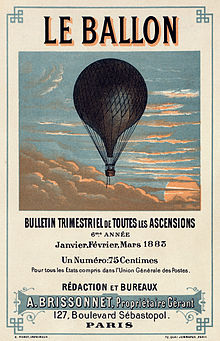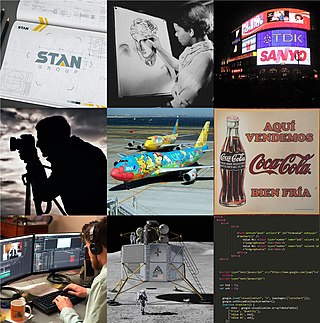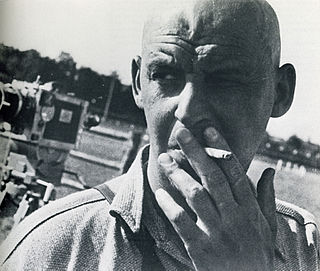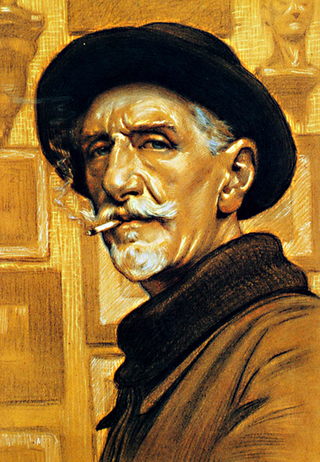
Affichiste is the French word for a poster artist or poster designer, a graphic designer of posters.

Affichiste is the French word for a poster artist or poster designer, a graphic designer of posters.
The name affichiste first appeared around 1780, but with a different meaning. It meant one involved in a poster's production and distribution, not its design: in particular, for producing handbills, setting up type and coordinating flyposting on walls, giving news on local and national events on a range of subjects. [1] Usually anonymous, these people are rarely considered artists, nor their products works of art.
At the end of the nineteenth century, poster art became a respectable art form, with the invention of large-scale colour lithography. (Chromolithography made its début around 1870. [2] ) Artists such as Jules Chéret, the brothers Léon and Alfred Choubrac, and Alfons Mucha became famous within the art world, working almost exclusively on advertisements. Almost simultaneously, all Western countries had their own nascent movements: in Britain, the Arts and Crafts movement, and then the Glasgow School of Art (built by Charles Rennie Mackintosh), and in Chicago, where artist William H. Bradley had worked for an advertising agency. [3]
In France, several famous painters such as Henri de Toulouse-Lautrec also worked on poster advertising for products or entertainments. Many illustrators also worked in advertising in addition to their work for illustrated newspapers.

Around 1900, posters in the Art Nouveau style started to appear, notably those by Leonetto Cappiello. The first dedicated street furniture for displaying posters appeared: in particular, the advertising column or "Morris column" (French : colonne Morris), together with large billboards, murals on buildings, and so on.
Little by little, these new media were considered to be within the realm of the artist and the designer, leading to the notion of the graphic designer as a creator of images and new forms, with a greater understanding of the possibilities of the new graphic forms and the possibilities that the poster gave for expression. It was rare at this time for someone to be known as an affichiste or "poster designer" specifically. The names are still unknown of some prolific poster designers working in the 1910s in Anglophone countries.
Art Déco and more generally Modern Art, let many poster designers come to greater attention and to express their talents in this medium.
Charles Gesmar, a protégé of Mistinguett since 1916, raised posters to high art, and his posters became enormously famous afterwards.
In the 1920s, poster art became a cornerstone of graphic art, with works by artists such as Paul Iribe and Cassandre, who established Raymond Savignac. Around this time, photomontage also came to the fore, allowing poster artists to combine photography and typography.
In the 1950s, techniques of xerography led to a new school of art which came to influence pop art.
In the 1950s, the Polish artist Roman Cieslewicz brought an important school of affichiste to the fore, mostly on films, theatre works, and propaganda for the Polish Communist Party) with a nihilism bent, in the context of state censorship. Artists Raymond Hains and Jacques Villeglé, meanwhile, took the name of affichistes for their photomontage work with collages of torn-up poster fragments. An exhibit of their works in 1957 termed their works Affiches Lacérées ("Torn Posters"). [4]
In the last three decades of the twentieth century, techniques of offset printing and digital image processing became more widely used, but these new methods and media led to a great deal of innovation in poster design with new modes of expression.

Graphic design is a profession, academic discipline and applied art whose activity consists in projecting visual communications intended to transmit specific messages to social groups, with specific objectives. Graphic design is an interdisciplinary branch of design and of the fine arts. Its practice involves creativity, innovation and lateral thinking using manual or digital tools, where it is usual to use text and graphics to communicate visually.

Photomontage is the process and the result of making a composite photograph by cutting, gluing, rearranging and overlapping two or more photographs into a new image. Sometimes the resulting composite image is photographed so that the final image may appear as a seamless physical print. A similar method, although one that does not use film, is realized today through image-editing software. This latter technique is referred to by professionals as "compositing", and in casual usage is often called "photoshopping". A composite of related photographs to extend a view of a single scene or subject would not be labeled as a montage, but instead a stitched image or a digital image mosaic.

Paul Rand was an American art director and graphic designer. He was best known for his corporate logo designs, including the logos for IBM, UPS, Enron, Morningstar, Inc., Westinghouse, ABC, and NeXT. He was one of the first American commercial artists to embrace and practice the Swiss Style of graphic design.

Aleksander Mikhailovich Rodchenko was a Russian and Soviet artist, sculptor, photographer, and graphic designer. He was one of the founders of constructivism and Russian design; he was married to the artist Varvara Stepanova.

A category of fine art, graphic art covers a broad range of visual artistic expression, typically two-dimensional, i.e. produced on a flat surface. The term usually refers to the arts that rely more on line, color or tone, especially drawing and the various forms of engraving; it is sometimes understood to refer specifically to printmaking processes, such as line engraving, aquatint, drypoint, etching, mezzotint, monotype, lithography, and screen printing. Graphic art mostly includes calligraphy, photography, painting, typography, computer graphics, and bindery. It also encompasses drawn plans and layouts for interior and architectural designs.

Milton Glaser was an American graphic designer, recognized for his designs, including the I Love New York logo; a 1966 poster for Bob Dylan; the logos for DC Comics, Stony Brook University, Brooklyn Brewery; and his graphic work on the introduction of the iconic 1969 Olivetti Valentine typewriter.

Constructivism is an early twentieth-century art movement founded in 1915 by Vladimir Tatlin and Alexander Rodchenko. Abstract and austere, constructivist art aimed to reflect modern industrial society and urban space. The movement rejected decorative stylization in favour of the industrial assemblage of materials. Constructivists were in favour of art for propaganda and social purposes, and were associated with Soviet socialism, the Bolsheviks and the Russian avant-garde.
Paul Colin born in Nancy, France, died in Nogent-sur-Marne. Colin was a prolific master illustrator of Decorative Arts posters. Alexandre-Marie Colin was a relative.
Vladimir Stenberg and Georgii Stenberg were Russian avant-garde Soviet artists and designers, best known for designing film posters for Sergei Eisenstein's movies, Dziga Vertov's documentaries and numerous imported films. The pair worked in a constructivist and, later, productivist styles, in a range of media, initially sculpture, subsequently theater design, architecture, and drafting. Their design work spanned clothing, shoes, and rail carriages, but they are most notable for their frequent use of film stills and their innovative approach to composition, which replaced traditional styles with non-narrative collage or assemblage. "Ours are eye-catching posters," Vladimir explained, "designed to shock. We deal with the material in a free manner. .. disregarding actual proportions. .. turning figures upside-down; in short, we employ everything that can make a busy passerby stop in their tracks. The inventive results included a distortion of perspective, elements from Dada photomontage, creative cropping, an exaggerated scale, a sense of movement, and a dynamic use of color and typography, all of which "created a revolutionary new art form: the film poster."
Tadanori Yokoo is a Japanese graphic designer, illustrator, printmaker and painter. Yokoo’s signature style of psychedelia and pastiche engages a wide span of modern visual and cultural phenomena from Japan and around the world.

Herbert Matter was a Swiss-born American photographer and graphic designer known for his pioneering use of photomontage in commercial art. Matter's innovative and experimental work helped shape the vocabulary of 20th-century graphic design.

The Museum of Design, Zürich is a museum for industrial design, visual communication, architecture, and craft in Zurich, Switzerland.

A poster is a large sheet that is placed either on a public space to promote something or on a wall as decoration. Typically, posters include both textual and graphic elements, although a poster may be either wholly graphical or wholly text. Posters are designed to be both eye-catching and informative. Posters may be used for many purposes. They are a frequent tool of advertisers, propagandists, protestors, and other groups trying to communicate a message. Posters are also used for reproductions of artwork, particularly famous works, and are generally low-cost compared to the original artwork. The modern poster, as we know it, however, dates back to the 1840s and 1850s when the printing industry perfected colour lithography and made mass production possible.
Graphic design is the practice of combining text with images and concepts, most often for advertisements, publications, or websites. The history of graphic design is frequently traced from the onset of moveable-type printing in the 15th century, yet earlier developments and technologies related to writing and printing can be considered as parts of the longer history of communication.

Jerry W. McDaniel is an American heterogeneous artist; graphics artist, illustrator, communication designer, educator and modernist painter. He distinguished himself by doing advertising work for numerous large corporations, creating posters, doing book and magazine illustrations, and influencing numerous students of advertising and communication design. In parallel with his commercial career he was a prolific multimedia artist, painting in acrylic and in watercolor, in various fields such as landscape, portraits, sports, and political graphics. He also designed sports stamps. He was one of the first illustrators to embrace computer graphics.

Eugène Ogé was a French poster artist and illustrator.

Andrey Logvin is a Soviet and Russian poster artist, graphic artist, designer in the sphere of graphic design and advertising. Academician of graphic design and member of Alliance Graphique International (AGI).Owner of more than 30 awards of the International and Russian competitions of design and advertising. The winner of the State Prize of the Russian Federation in the field of literature and art for 2000. He is presented in the directory "Who is who in Graphic Design". He is one of the 108 leading graphic designers in the book is "All Men are Brothers - Designer's Edition". In 2004 the Chinese Lignan Art Publishing House published the monograph "Andrey Logvin" on 165 pages. The poster "Life Is a Success" has become a calling card of the designer.

Walter Herdeg was a Swiss graphic designer, noted for his travel posters and work with Graphis Magazine, who was awarded an AIGA medal in 1986.

Valentina Kulagina, full name Valentina Nikiforovna Kulagina-Klutsis was a Russian painter and book, poster, and exhibition designer. She was a central figure in Constructivist avant-garde in the early 20th century alongside El Lissitzky, Alexander Rodchenko other and her husband Gustav Klutsis. She is known for the Soviet revolutionary and Stalinist propaganda she produced in collaboration with Klutsis.

Art Nouveau posters and graphic arts flourished and became an important vehicle of the style, thanks to the new technologies of color lithography and color printing, which allowed the creation of and distribution of the style to a vast audience in Europe, the United States and beyond. Art was no longer confined to art galleries, but could be seen on walls and illustrated magazines.